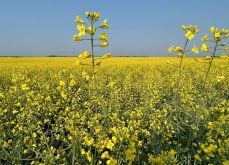EDMONTON – Bison will adapt to owners who want an intensive production system, to those who take a hands-off approach, and to anyone in between.
Three producers told delegates to the International Bison Conference last week that bison will accommodate most production styles.
Susan Maass of Colorado has a background in showing pedigreed cattle and dogs. She uses an intensive bison management system. By putting only one bull with small groups of bison cows, she is able to direct the mating.
“It requires quite a bit of planning which females go with which bulls,” she said.
Read Also

StatCan stands by its model-based crop forecast
Statistics Canada’s model-based production estimates are under scrutiny, but agency says it is confident in the results.
The method allows her to keep detailed herd and pedigree records, which are important on the show circuit where she has sold some of the highest priced bison in North America.
She raises about 67 breeding cows on 275 acres. This year she will have four separate breeding pastures, but has had as many as six.
Show your stuff
Along with a selective breeding program, Maass decided to use the show circuit as a promotional tool.
“Eventually one has to dive into the show and sale and see where you compare. You’re really able to compare animals with other breeding stock and that’s been very important,” said Maass.
She recommends starting out at smaller shows to learn selection and how to prepare bison for show.
“You need to have a good strong animal or you do your reputation long-term damage.”
Josie Van Lent-Staden said her farm introduced bison as a method of diversification into lower maintenance animals.
Bison are one component of the 5,300 acre grain, elk and cattle farm in eastern Alberta, near Mannville.
“Some people say we’re diversified. I say we’re spread thin,” said Van Lent-Staden.
Low maintenance
Because the soil varies from good loam to sandy, the family wanted animals that could graze on poorer quality soils without much fuss.
“We found they were easy to work with and labor saving for our operation,” she said.
Because bison don’t demand a lot of attention, they’re not coddled. During calving they get checked once a week unless one is in distress.
Before breeding and calving, the animals are fed oats with a mineral and vitamin supplement.
Duane Lammers, manager of a 1,000-cow bison ranch in Hermosa, South Dakota, said he doesn’t like to get his clothes dirty on the ranch. His 25,000-acre property is broken into 2,100-acre pastures where the bison get moved every four to eight days depending on the grass.
Occasionally, Lammers has moved the entire herd by himself on foot.
“You don’t have to go much faster than a golf cart if you’re doing it right.”
The Triple 7 Ranch follows a holistic resource management approach to raising livestock. Managers try to improve the carrying capacity, take care of the environment and provide a good life for staff on the ranch.
They even let the cows wean their own calves.
“There’s a lot less health problems and one heck of a lot less work,” said Lammers.
When sorting or selling animals, a gate cut selects most of the bison.
Lammers said the relaxed attitude may not work for everyone, but he is comfortable with it.
















